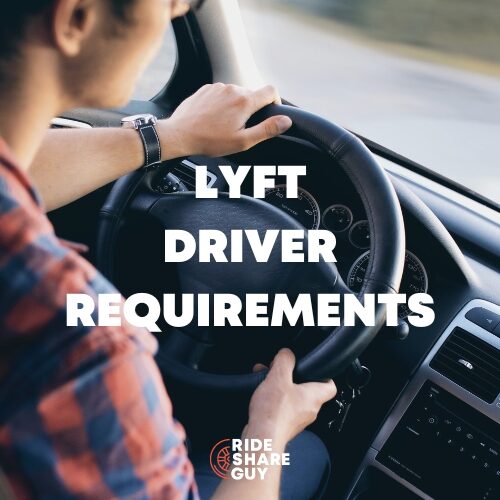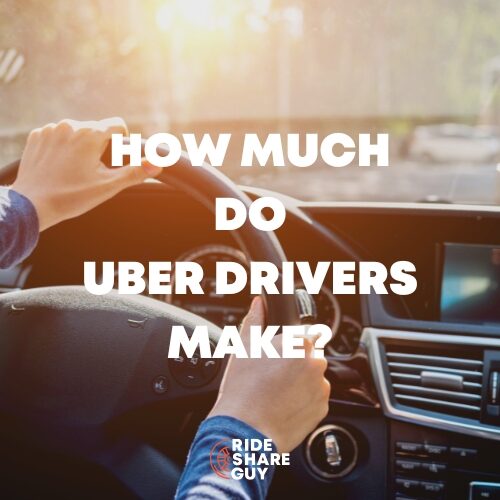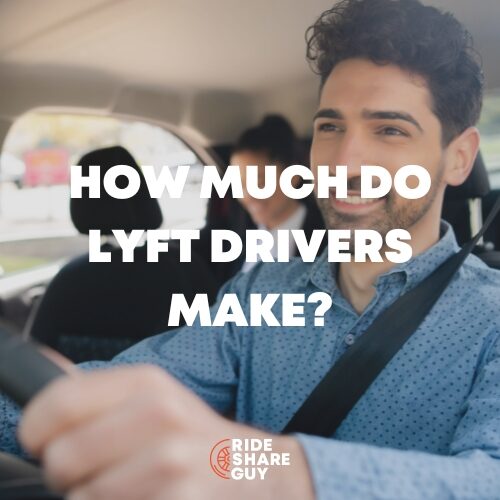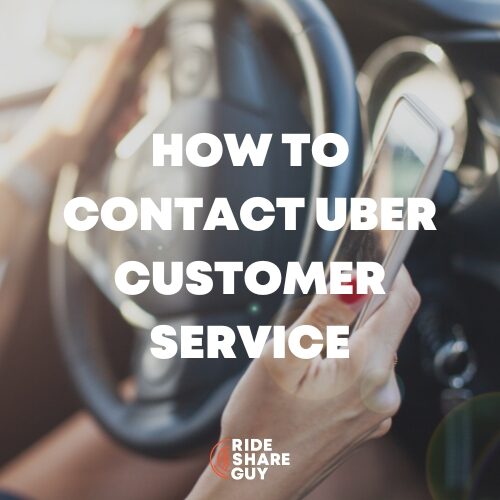Logging into your app to find a Lyft deactivation notice is one of the most frustrating experiences a rideshare driver will ever encounter.
This event is not uncommon. Gig workers everywhere, whether it’s Uber, DoorDash, or Amazon Flex, have all come up against this headache. Even when drivers have good reviews, safe driving, and follow community guidelines, the deactivation can strike.
Some independent contractors say it’s a regular occurrence. Every so often, a deactivation will just land without warning. Then you have to follow up and find out why it happened, and regain access to driving or delivery gigs.
While this sounds stressful, there’s good news. There are many things you can do to prevent deactivations from happening in the first place. And if you do get deactivated, there are ways to speed up the deactivation appeal process so you can get quickly back on the road and avoid frustrating back-and-forths with Lyft support.
Why Lyft Drivers Get Deactivated
There are a number of reasons that a Lyft driver may get deactivated. Whether you’re a new driver dealing with your first deactivation or you’re an old hand at butting heads with Lyft’s deactivation policy, here are the most common reasons.
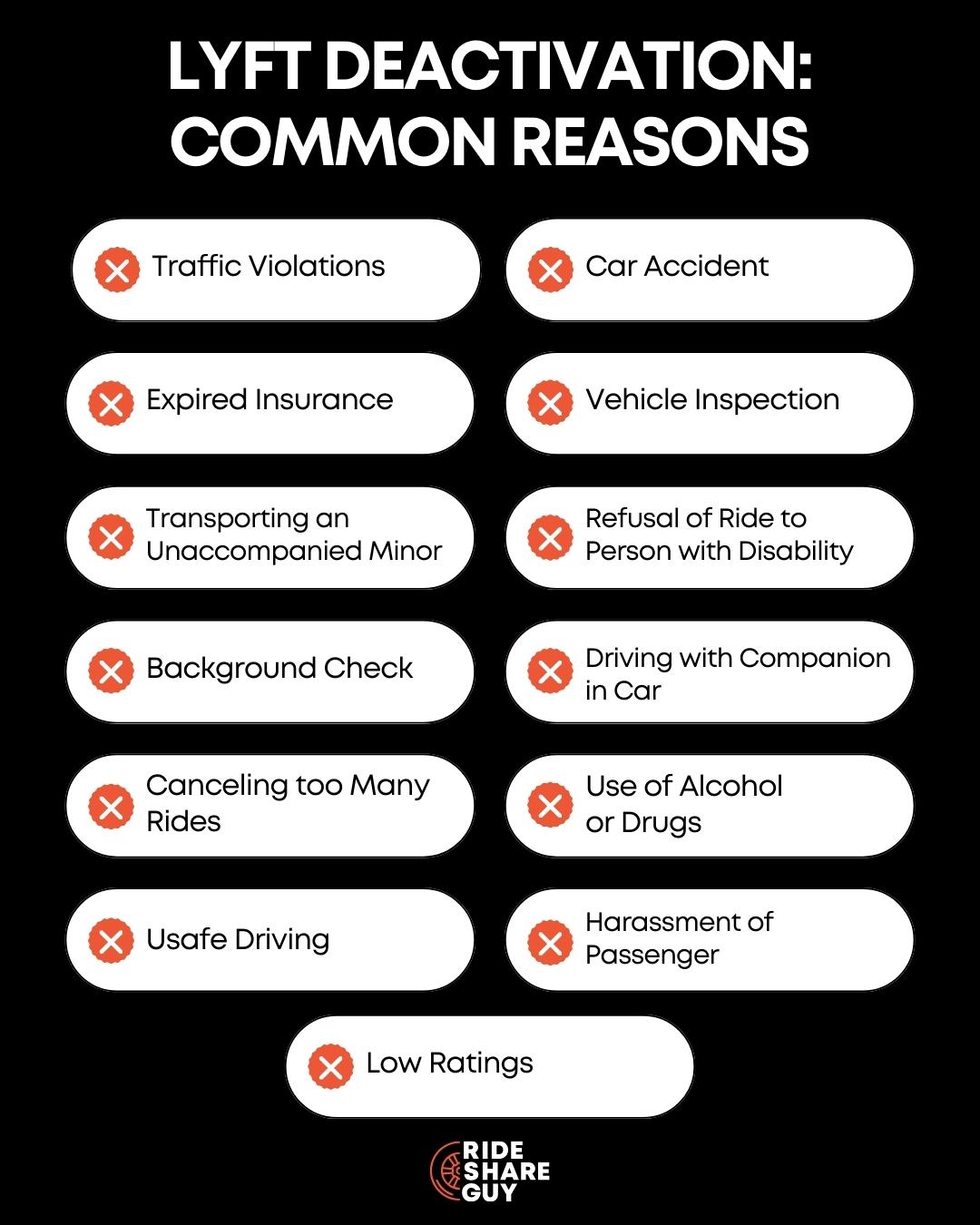
1. Traffic Violations
Make sure you’re aware of local state laws and traffic laws and obey them to stay in compliance and keep your passengers safe.
Lyft has a zero-tolerance policy for any traffic violations, and your account will be deactivated for any infraction. Whether it’s running a red light or getting in a hit-and-run, breaking the law results in a permanent deactivation.
If a passenger mistakenly states you broke the law (i.e., they weren’t aware you were making a legal right turn at a red light), you can share your version of events with the Lyft support team.
2. Expired Insurance
Make sure you maintain a current vehicle registration, a current driver’s license, and up-to-date car insurance. Beyond keeping this information up-to-date, make sure that Lyft has document copies.
If your insurance policy is expired, Lyft will immediately deactivate you. Even if the policy ID number is valid and a phone call to your provider would quickly prove you have renewed your author policy, Lyft expects drivers to keep updated insurance documents on file.
Fortunately, this is an easy problem to resolve. After you scan your updated insurance card, Lyft will reactivate your account.
Related:
3. Low Ratings
Low driver ratings can lead to account deactivation, as these scores indicate that you are not providing a positive passenger experience.
Lyft does not have an official minimum score you must maintain, but based on drivers we’ve talked to, a “low” score is a big problem.
The rideshare app will look at your score relative to other driver scores in your area. If the average rating in your area is 4.6 and your score is 4.1, you are likely going to be deactivated.
Some insiders say the score to shoot for is 4.7 or better, and that anything at lower can jeopardize your driver standing.
Maintain the highest score possible by keeping your car clean, especially the interior, driving safely, and being friendly and courteous.
Related:
4. Transporting an Unaccompanied Minor
This is one of the quickest ways to get deactivated. Lyft has strict rules against transporting an unaccompanied minor without parental consent.
Passengers must be at least 18 years of age, or in the presence of an accompanying adult. Many teenagers will have the app and the ability to pay, but you still cannot legally transport them.
It may be hard to tell someone’s age, and you don’t want to mistakenly reject someone who is of age. If you’re unsure, you can ask the passenger if they are 18 or older.
If the ride requester is obviously a minor, you can cancel the ride and explain that you are not allowed to take them.
5. Background Check
Failing a background check is a sure way to get deactivated. Even if you pass an initial background check when you sign up to become a Lyft driver, you will need to maintain a clean criminal record and driving record.
Lyft will occasionally run updated background checks. If a new issue comes up, including minor traffic violations, you could be deactivated as a result.
6. Canceling Too Many Rides
Drivers can be deactivated for canceling too many rides. Ride cancellations should be done sparingly when the driver cannot accommodate the passenger’s request. They should be done quickly and courteously to avoid any delays.
Sometimes cancellations are unavoidable and in the passenger’s best interest. For example, if you’re stuck in traffic or you miss the freeway exit to pick up your passenger, it would be quicker and easier for another driver to offer the passenger a lift.
7. Unsafe Driving
Drive safely. If you drive aggressively, you can be deactivated even if you haven’t technically violated any traffic laws.
If enough passengers report your driving as unsafe, Lyft can deactivate your account. Keep tabs on your ratings and driving score. Here, you can look out for any passenger complaints about your driving.
8. Car Accident
If you or a passenger report that you are in a car accident during a Lyft trip, your account will be placed on hold. If the accident is minor, send photos or dashcam footage to Lyft and you can probably get the hold removed very quickly.
For more serious accidents, your vehicle will need to be fully repaired. Lyft may require additional information, including a detailed accident report. Another Lyft vehicle inspection may also be required.
9. Vehicle Inspection
Cars approved to drive for Lyft must pass a 19-point vehicle inspection. This inspection is more focused on vehicle safety than cosmetics, and common reasons vehicles fail are bald tires (not enough tread) or worn windshield wipers.
A vehicle inspection is required every year. If you fail an annual inspection, your account will be deactivated until you make the needed repairs and can pass.
Related:
10. Refusal of Ride to Person with Disability
It’s illegal to refuse a ride to someone based on their race, religion, age, sex, gender identity, or disability. The Americans with Disabilities Act (ADA) requires you to make reasonable accommodations for passengers with disabilities, including accepting any service animal.
That said if you can’t accommodate a passenger with limited mobility despite reasonable efforts, then you may need to cancel the ride.
A driver shared with me a time he had to cancel a ride because he could not accommodate a passenger with a walker. Her range of motion was so restricted that she could not physically walk into the vehicle. This passenger needed someone to lift her in and out of a seat, something not reasonable to expect of a driver.
If you do need to refuse a ride to a person with a disability because you cannot accommodate them, contact Lyft proactively to head off any complaints and let them know of the incident.
Related:
11. Driving with a Companion in the Car
As a Lyft driver, you and your Lyft passenger(s) are the only persons authorized to be in the car. You are not allowed to have a friend, family member, or any other person in the car with you — even if that person is there for your added personal security.
There’s added liability for Lyft when you have another person in the car. Lyft can’t vet that person or take accountability for their behavior.
Additionally, a passenger may be uncomfortable being picked up by a Lyft driver and one or more of the driver’s companions. They might feel unsafe getting into a car with two or more strangers.
12. Use of Alcohol or Drugs
Being caught using drugs or alcohol is a major offense and one of the surest ways to get your account deactivated. There are laws against driving under the influence (DUI) in every state.
Beyond that, Lyft has a zero-tolerance policy toward any drivers being under the influence while driving. Doing so will lead to an immediate, permanent deactivation.
Similarly, you cannot allow passengers to use drugs or alcohol in the car. They cannot drink or have an open bottle of alcohol, even though they are not driving, as this is also illegal and goes against Lyft’s policies on alcohol and drug use.
13. Harassment of Passenger
Harassing a passenger is another major violation that may lead to instant deactivation. This may happen if a driver makes an inappropriate sexual comment or even tries to touch a passenger in the car. In some instances, it may be a driver flirting or just trying to be friendly.
If these allegations arise, it can be hard to defend yourself since it’s your word against the passenger, and the Lyft platform tends to err on the side of rider safety.
How to Tell Your Lyft Account Has Been Deactivated
Just logging in to the Lyft app is the easiest way to tell whether or not your account has been deactivated. If you can sign in and give rides, your account is still active. However, if you get a pop-up message reading, “Your account has been deactivated,” then you’ll know your account is suspended.
To find out why this has happened, look through your app messages or emails to see if there are any communications about your Lyft account.
You can also look through driver feedback and ratings and check your overall account status.
How to Get Reactivated with Lyft
If you have been deactivated, here are some steps to follow to get the ban lifted so that you can start driving again.
Find out why you’ve been deactivated
Figure out why you’ve been deactivated. Look through ratings and reviews. Contact Lyft Support. There may not be an immediate answer. If Lyft needs to finish an investigation, you may need to sit tight for a few days or more.
Gather information for an appeal
Information includes anything to support your side of the story. This includes driver ratings, incident reports, screenshots of text conversations, or webcam footage.
Appeal the deactivation
Contact Lyft and ask them to reactivate your account. Present the information you have. Be prepared for follow-up questions. Respond to all communications promptly.
While going through the appeals process, do not re-apply to be a Lyft driver with a new account. This won’t work, since your driver account is connected to your Social Security number (SSN).
It may take anywhere from a couple of business days to a couple of weeks to get a final resolution.
Related:
How to Avoid Lyft Deactivation
Here are some tips for avoiding a Lyft deactivation in the first place so that you won’t have to go through the appeals process to get back up and running.
Keep documents up to date
Keep your documents up to date. This includes insurance, driver’s registration, and car insurance. Set a reminder on your calendar, or ask Siri or Alexa to remind you.
Drive cautiously
Drivers appreciate you wanting to get them to their destination quickly, but they value safety. Don’t cut off cars, weave in and out of lanes, or run red lights that were yellow just a split second ago. Easy does it. You’ll get more passengers upset by aggressive driving than cautious driving, and Lyft will not penalize you for driving too cautiously.
Follow the rules of the road
Follow all traffic laws and ensure your passengers are also compliant. This may mean asking them to put on their seatbelt or not stand up and stick their head out of your moonroof.
Keep your car clean
Keep your car clean. In our experience, the inside of your car matters more than the outside. Don’t show up in a car that looks like you’ve been mudding, obviously, but if it’s a few days overdue for a carwash passengers generally won’t mind. What they do care about is a clean interior. Your car should have clean floor mats and seats, no crumbs or garbage, and a fresh-smelling scent.
Report incidents when they occur
Report any incident that occurs, including minor fender benders. This shows you have nothing to hide and are following all of Lyft’s guidelines.
Contact customer support proactively
When it comes to potential incidents, contact customer support proactively. Let’s say you had a belligerent passenger who could not walk straight and looked ready to vomit. If you need to cancel on this person, do so and then contact customer support and let them know why. You can protect yourself from any complaints about ride refusal.
Get a dash cam and use it
When possible, get a dash cam and use it. It’s for your safety and your passengers. Some states have privacy rules around dash cams, so make sure to check your state laws first.
Keep records of your driver ratings
Take screen grabs of glowing reviews, your overall star rating, and driver stats. Yes, this information is tied to your account profile. But if you find yourself deactivated, you will lose access to this data. You want this information to build your case for an appeal.
Taking a phone screen grab every day or so isn’t hard and it’s an easy way to protect your livelihood.
Verify the passenger’s name
Before picking up a passenger, verify their name. You don’t want the wrong passenger to get into your car, only to find that out when you try to drop them off at the wrong destination. And it’s also a matter of security. Both the driver and the passenger know who to expect and what their app ratings are.
If someone comes out to the car, ask them, “Are you expecting a Lyft ride?” They may say they were waiting on an Uber, or they want to know if they can just hop in and take a ride without the app.
Then ask them for their first name if they are expecting a Lyft. If it’s an especially common first name, you can ask, “Mike, you are going to the wharf on 15th Street, right?”
Most passengers have no issue giving their first name. If they ask for your name, you can do so and refer them to the app which has your details and license number, and let them know you want to avoid any passenger mix-ups.
Don’t stay parked where you drop someone off
After you drop someone off, you don’t want to burn gas driving around. You want to stay put and wait for your next ride. But don’t stay parked right where you dropped off your last passenger. It could creep them out. They may think you are stalking them. Drive at least a few blocks down the street to a parking spot out of the visual range from the last drop-off point.
Be nice
Be nice to your passengers. Some drivers are rude or surly, or even spend the entire ride complaining about driving for Lyft. This is not a pleasant experience for the passenger.
On the other hand, you don’t want to be overly friendly — especially if you are a male driver with a female passenger since she might mistake the gesture for unwanted sexual attention.
This also means don’t argue with the customer. If they insist they entered at a different address that’s two blocks away, or they want you to drop them off on the other side of the road when it will take forever to make a left turn, just do it. It’s not worth an argument or a poor review.
TIP: Have a Back-up Gig
If you drive for Lyft that’s great, but don’t rely on smooth sailing with Lyft all of the time. You should have other back-up side hustles too, like Instacart, DoorDash, or Uber.
When it’s slow with Lyft, you’ll have something else to fall back on. If you have a few bad trips in a row on Lyft, you can take a break from Lyft and still earn money. This will keep you in better spirits, and a better driver, for your Lyft riders.
And if you need to go through the Lyft appeals process, you’ll be more clear-headed and less impatient when talking to the appeals team if you have income coming in and you’re not stressed and broke waiting to get back on the road for Lyft.
Frequently Asked Questions
Here are some of the most common FAQs that drivers have about a Lyft deactivation.
How long do you have to wait to reapply with Lyft?
Most drivers need to wait at least three (3) months before they can reapply. Other drivers say the wait time is actually six (6) months or longer.
There is no direct way to reapply to Lyft after being deactivated. You just have to contact Lyft and ask for them to reactivate your account; you cannot start a new driver application.
Can you be deactivated for a low acceptance rate on Lyft?
No, you can’t be deactivated by Lyft for a low acceptance rate. Drivers, however, can be deactivated for a high cancellation rate. This is where you accept a ride and then cancel it afterward and do not pick up the passenger.
What’s the maximum cancelation rate to be deactivated by Lyft
There is no maximum cancellation rate that will trigger a deactivation. Lyft will look at your overall driver ratings and compare your cancellation rate to that of other drivers in your area. If your cancellation rate is higher than average, you will receive a warning in the app that your account is at risk of suspension.
What is the appeals process for Lyft deactivation?
There is no formal appeals process for getting reactivated with Lyft. You’ll need to reach out and contact a Lyft representative and ask them to restore your account. Explain your side of the story and share any relevant documents. You may need to find out why you were deactivated in the first place.
Tips for appealing your deactivation
- Visit a Lyft driver hub in your area to speak with a representative directly.
- Reach out as soon as possible. Within 14 days, Lyft. can reactivate your account. (Beyond that, you would need to re-apply after at least three months have elapsed.)You can reach out at a center, via chat, or by call
- Be honest. If you made an honest mistake, admit you were in the wrong, but the bottom line is you’ve learned your lesson, and you won’t do it again.
- Keep your emails and other communications professional, succinct, and relevant.
- Share supporting details that build the case that you are a high-quality driver, such as your high star rating or positive customer reviews.
- Give them at least two (2) business days to reply to any email before you follow up again. You don’t want to be pushy or annoy the rep who has the discretion to reactivate you or keep you banned.
Driver’s Take
If you’re a Lyft driver dealing with a deactivated account, it can be stressful. Not only are you defending yourself against some potentially unfair claims, but your livelihood is under fire.
But take heart. Lyft does reactivate drivers who have been deactivated, and the process can move very quickly.
Even if the deactivation is a mistake and the appeals process is long, drivers can get their accounts restored. Pursue all avenues of customer support outreach, including email, chat, phone, and social media, and in some instances, you may need legal help. There are affordable law firms that specialize in helping rideshare drivers get back on the road.
